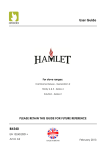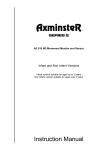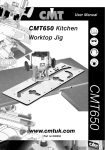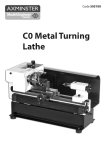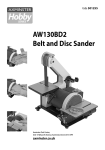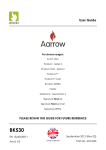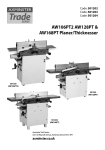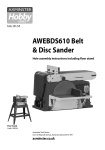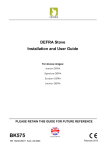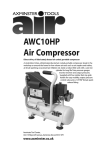Download Arada BK605 Installation guide
Transcript
Cassette Stove Installation Guide Height Width BK605 EN 13240:2001+ Amd. A2:2004 November 2013 Rev01 Please carefully read through the entirety of this installation guide once before commencing installation. Should you have any questions about our stoves that are not covered in this manual, please contact the Arada retailer in your area, or call our technical support department on 08448 567181. You should retain these instructions for future reference. Table of Contents Warnings ............................................................................................................................................................. 3 Health and Safety ........................................................................................................................................... 3 Installation Requirements .............................................................................................................................. 4 Hearth.................................................................................................................................................... 4 Combustible Materials ....................................................................................................................... 4 Air for Combustion ............................................................................................................................... 5 Flues and Chimneys............................................................................................................................. 5 Installing the Stove ......................................................................................................................................... 7 Removing the Door .............................................................................................................................. 7 Removing the Throat Plate and Liners .............................................................................................. 7 Assembling or removing the Grate Bars ........................................................................................... 8 Fitting the Flue Outlet ........................................................................................................................... 7 Sealing the Stove to the Fire Surround .............................................................................................. 8 Fitting the frame/trim ............................................................................................................................. 8 Commissioning the Stove.............................................................................................................................. 9 2 Arada Installation Manual Installation Guide Warnings It is a legal requirement that the installation of all new or replacement, wood or solid fuel heating appliances must obtain Building Control approval from your local authority. This can be done by using a qualified heating engineer, affiliated to a government approved competent persons scheme such as operated by HETAS. If in doubt, contact HETAS limited, telephone: 0845 634 5626 or visit www.hetas.co.uk All local regulations, including those referring to National and European standards, need to be complied with when installing the appliance. This stove must not be installed into a chimney that serves any other heating appliance. There must not be an extractor fan fitted in the same room as the stove as this can cause the stove to emit fumes into the room. Any manufacturer’s instructions must not be taken as overriding statutory requirements. Arada Ltd will not be responsible for any consequential or incidental loss or injury however caused. Health and Safety Before any installation work is undertaken consideration must be given to the Health and Safety at Work Act 1974. Safe working practices should be followed at all times. Please consult health and safety guidelines for advice on handling heavy and/or large items. During installation ensure that adequate precautions are taken to avoid unnecessary risk to yourself or any householder. Fire Cement In particular the danger from the caustic nature of fire cement should be avoided by using these accepted methods: Wear gloves when handling fire cement. Wear goggles when chiselling or looking up chimneys. Asbestos This stove contains no asbestos. If there is a possibility of disturbing any asbestos in the course of the installation then please seek specialist guidance and use appropriate protective equipment. Arada Installation Manual 3 Installation Guide Installation Requirements Hearths and Recesses The stove should be installed on a surface with adequate load bearing capacity. If the existing construction does not meet this prerequisite, suitable measures (e.g. load distributing plate) should be taken to achieve it. Please pay particular attention when examining existing building work for suitability to meet the following requirements. Hearths and recesses for Cassette stoves should have a sufficiently flat surface to allow a good seal to the stove body to be created during its installation. Stonework, uneven bricks etc. may need further work to ensure that this can be achieved. Cassette stoves should be installed into a recess on a non-combustible surface not less then 125mm thick (conforming to Building Regulations) of suitable load bearing capacity. Allowances should be made for the expansion and contraction of materials which are fitted up to and near the appliance. Dimensions of the constructional hearth for all stoves (including any ’hole in the wall’ type installation) should project at least 500mm forward of the front of the appliance and 150mm at the sides. The surface of the hearth should be free of combustible materials. The superimposed hearth for all installations should project at least 225mm forward from the front of the appliance and 150mm either side of the edge of the appliance. In most buildings with solid concrete or stone floors, the requirement will be met by the floor itself, but mark the hearth to ensure floor coverings are kept well away or use different levels to mark the hearth perimeter. Please be aware that hot air can cause staining above the fire in a similar fashion to walls above radiators. To help prevent this and cracking we recommend that plastering above the fire should be fitted with reinforcing expanding mesh for at least 220mm above, and the full width of the fire. You should also use a suitably heat resistant plaster. When installing the stove into a recess it is important that the front outer jacket edges sit 5mm proud of the wall surface to enable the trims to clip onto the fire. Combustible Materials Please view the product sheet which accompanied your stove for specific minimum distance to combustibles measurements. Ideally, adjacent walls should be of suitable non-combustible construction, preferably brickwork. In large fireplaces take care that any supporting beam is protected by a 13mm (0.5”) sheet of Masterboard or Superlux spaced 12mm (0.5”) off the surface with strips of non-combustible material. Make sure that there is a gap between an un-insulated flue system and any combustible material. This gap must be at least 3X the outside diameter of the flue pipe, or 1.5X the flue diameter to non combustible surfaces. 4 Arada Installation Manual Installation Guide Air for Combustion All stoves require ventilation to burn safely and correctly. There are a number of requirements that need to be met when installing a stove, for example, allowing for the permeability of the house (air permeability is the general seepage of air into the house via air vents, doors and windows etc.) There must always be a permanent means of providing air for combustion into the room in which the stove is installed. Air starvation will result in poor flue draw and may cause smokiness in the room. A permanent vent with a total free area of at least 550mm² for every kW above 5kW should be connected directly to the outside air. Alternatively this air can be supplied through an external wall of an adjacent room, which itself has to be connected to the room the appliance is installed by a permanent vent of the same size. Note: if the appliance is fitted with a draught stabiliser or if one is fitted to the flue pipe or chimney in the same room as the appliance, then the permanent air entry opening (or openings) should be increased by 300 mm² for each kW of rated output. If there is more than one appliance in the property then each appliance must be supplied with adequate combustion air so that all appliances can be lit simultaneously. The positioning of any air vent must be so that it cannot be liable to blockage or obstruction. Ideally it should also be positioned where it is unlikely to cause a cold draught. The fitting of an extractor fan in the same room as the stove, or an adjacent room is not permitted. For more detailed guidelines on required ventilation sizes please refer to the ‘HETAS Guide’ which can be found on HETAS’ website. If you plan to use an external air supply on a suitable stove, and have bought the appropriate Arada External Air Supply Kit, please refer to the instructions included with the kit on how to install it. The accompanying stove technical product sheet states whether or not your appliance is compatible with a Direct Air Supply Kit. Flue and Chimneys The stove must be connected to a suitable and efficient flue so that products of combustion (fumes) from the stove are expelled to the outside air. Please remember that chimney draught is dependent on four main factors : • Flue gas temperature • Flue size • Flue height • Flue terminal To ensure a good up draught it is important that the flue gases are kept warm and that the flue size suits the stove. The termination of the outlet at the top of the flue also needs to comply with Building Regulations. The minimum effective height of the flue must be at least 4.5 metres from the top of the stove to the top of the flue outlet. When warm the flue draught should be between 0.1 to 0.2 mb. The draw of a chimney / flue can vary in different weather conditions and the customer should be made aware of this. Arada Installation Manual 5 Installation Guide Failure to correct an over-drawing flue will invalidate the warranty. A chimney may comply with regulations but could still be subject to down draught and similar problems. A chimney terminating above the ridge level is generally less likely to suffer such problems. If a new chimney is being provided it should fully comply with the relevant Building Regulations that specify the requirements for solid fuel burning installations. Suitable types of chimney include the following : Masonry Chimney : Built with clay or concrete liners, or a chimney block system meeting Building Regulations. These types of chimneys should be installed in accordance with the Building Regulations and BS 6461:Part 1. Factory Made Insulated Chimney : Complying with BS 4543:Part 2 (often called “Class 1 prefabricated metal chimney”). These types of chimneys should be installed in accordance with Building Regulations and BS 7566: Parts 1 to 4. Due to the gradual introduction of Europe Chimney Standards ,chimneys will be specified according to their performance designation as defined in BS EN 1443 that covers the General Requirements for chimneys. The minimum performance designation required for use with solid fuel burning stoves is T450 N2 S D3. The flue and chimney installation must be carefully checked by a competent person before fitting the stove to ensure it is suitable and will work safely. If the chimney is old (ie: built of brick or stone without a liner) or being opened up for reuse additional checks and smoke testing as described in Appendix E of the Approved Document J 2002 Edition should also be carried out to ensure the flue and chimney are in good operating condition. Check the existing flue is in good condition with suitable access for collection and removal of debris. If the flue size is more than 225mm (9”) diameter or 200mm (8”) X 200mm (8”) square, a suitable lining of 150mm (6”) diameter should be fitted, or if the flue length is over 5.5 metres one size larger than the appliance outlet should be fitted. This should be a double skin stainless steel flexible liner that is independently certified for use with solid fuel. Details of suitable linings for use with wood and solid fuel are given in the Official HETAS guide that can be viewed on their website at www.hetas.co.uk. It is also important that suitable flue pipe complying with the Building Regulations is used to connect the stove to the flue in the chimney and that suitable access is provided into the flue for regular inspection and sweeping of the flue ways. The installer should comply with Building Regulations requirements in respect of providing a Notice Plate giving details on the chimney, flue lining, hearth and fireplace installation. Chimneys should be as straight as possible. Horizontal runs should be avoided except where the rear outlet of the appliance is used, in which case the horizontal section should not exceed 150mm (6”) in length unless the following criteria is met (at which point a horizontal run is allowed up to 450mm in length): The appliance must either be DEFRA exempt or designated by Arada to only burn authorised smokeless fuel. (The user must also accept that they can only use smokeless fuel). A chimney calculation in accordance with BS EN 133841: 2002+A2:2008 Chimneys. Thermal and fluid dynamic calculation methods. Chimneys serving one appliance. has been carried out and the results show the chimney will operate safely. One copy of the results must be 6 Arada Installation Manual Installation Guide retained by the installer and another left with the user. Where an appliance with a vertical chimney exit is used, there is at least 600mm between the top of the appliance and centre line of the horizontal section. There is access to inspect and clean the horizontal section. This can be either through the appliance or via an inspection plate on the flue pipe. The minimum required distance to combustible material or wall surface required by the appliance and connecting flue must be maintained. The appliance manufacturer has seen a dimensional layout drawing for the installation together with a chimney calculation and gives written consent that the appliance can be used with the proposed chimney configuration. The chimney manufacturer has seen a dimensional layout drawing for the installation, together with the chimney calculation and gives written consent that their chimney system can be used with the proposed configuration. If the stove appears to be working hard but produces very little output to the room it is likely that excess draw is present in the chimney, and that heat is being sucked out of the appliance and up the chimney. If this is the case we recommend the fitting of a draught stabiliser in preference to a flue damper, in the interest of safety and efficiency. Installing the Stove To make the stove easier to manoeuvre (thus safer) we recommend you remove the following parts which can then be refitted when the stove is in its final position: Grate Bars Operating Tool Liners Ash pan Door (To help prevent the glass from breaking) Throat Plate Removing the door. Open the door so that it’s perpendicular to the stove body and then carefully lift the stove door upwards of its hinges. To replace the door reverse the instructions above. Removing the throat plate and liners. The throat plate rests on both the side liners and tertiary air bar at the rear of the firebox. With the fire door removed or open push up on the throat plate with the palm of one hand. With the other, remove the side liners and then lower the throat plate forward. It is easier to lower one side of the throat plate first to help remove it from its position and to allow it to fit through the opening of the stove. Once the throat plate has been removed you can also remove the rear liner(s). To replace the liners/throat plate follow the steps above in reverse. Arada Installation Manual 7 Installation Guide Assembling or removing the grate bars. The grate in the stove, comprises of a series of reciprocating cast iron grate bars, seated on a pivoted ‘comb’. All bars in the grate are identical, but every other bar is turned through 180 degrees, with the ends of the bars marked ‘H’ sitting on the high sections of the comb, and the ends marked ‘L’ sitting on the low sections. To assemble the grate, fit bars to the low sections of the comb first, inserting ends marked ‘H’ into the rear channel with the groove on the underside of the bar is located on the up stand tab, and then lowering end marked ‘L’ onto the low section of the comb. The upper bar is fitted in a similar manner, but with the end marked ‘L’ inserted in the rear channel, and the end marked ‘H’ seated on the high section of the comb. Fitting the Flue Outlet The flue outlet spigot has already been fitted to the top of the stove at the factory. The flue pipe must be fitted inside the outlet spigot. Failure to do so could result in the spillage of condensation running down the flue. Flue Pipe Inside Outer Spigot Fire cement should be used to create an airtight seal between the flue and spigot. Sealing the stove to the fire surround In order for the stove to operate correctly and at maximum efficiency it is necessary to achieve a good seal between the back face of the stove convector section, the stove back base sections and the decorative fire surround and recess. This should be achieved using fire cement. Any void surrounding an inset stove when installed should be filled with fire cement in the interest of safety and efficiency. Fitting the frame Please refer to the instructions included with the frame for information on how to fit them. 8 Arada Installation Manual Installation Guide Commissioning the Stove Before handing over the installation to the customer it is a requirement under Document J (of the Building Regulations for England & Wales) that the appliance is lit and the functioning of the chimney system is checked for satisfactory operation. Be sure that the chimney is operating and all smoke and fumes are vented to the atmosphere through the chimney terminal. Check all joints and seals. Clean the outside of the cold appliance with a lint free cloth or shoe brush to prevent any stains becoming burnt on. Check the flue draught which should read 1 - 2mm, or 0.1 - 0.2 mbar. For a registered competent persons scheme, such as HETAS, please complete a Certificate of Compliance, which is used for checking and reporting the installation as imposed by the Government. Otherwise please ensure the installation is approved by your local building control officer. Ensure a Carbon Monoxide alarm is fitted. This must be between 1m to 3m from the appliance, and approximately 150mm below the ceiling level. A fireguard conforming to BS 8423:2002 should be used in the presence of children and old or infirm people. A notice plate should be provided containing information on the performance characteristics of the hearth, fireplace, flue or chimney. Explain the following to the customer: How to operate the riddling mechanism and air control lever. The importance of an adequate air supply to the room. The importance of regularly having the chimney swept / inspected. That a protective glove should be used when operating the stove. Arada Installation Manual 9 Cassette Stove Installation Guide Arada Ltd The Fireworks Weycroft Avenue Axminster Devon EX13 5HU Telephone: +44 (0)1297 35700 Technical Helpline: +44 (0)8448 475107 Please Note: Arada has a policy of continuous product development and therefore we reserve the right to amend specifications without prior notice. Due to printing cycles, items, options or information may be offered prematurely or now be obsolete, please check with your retailer or dealer. BK605 November 2013 Rev01












